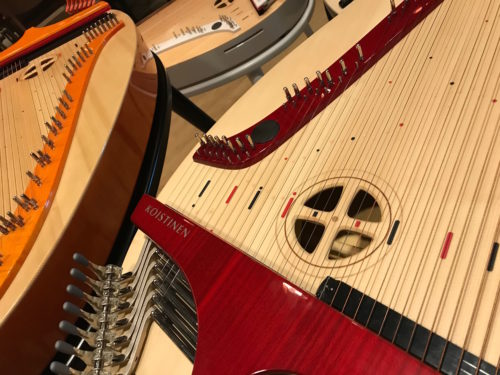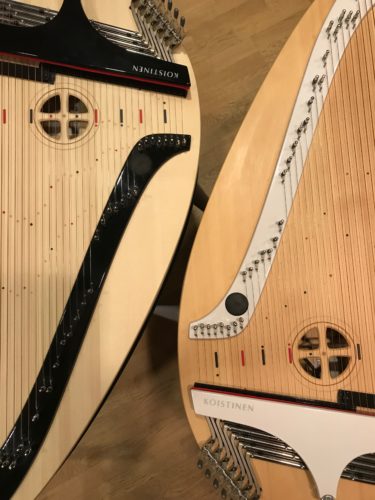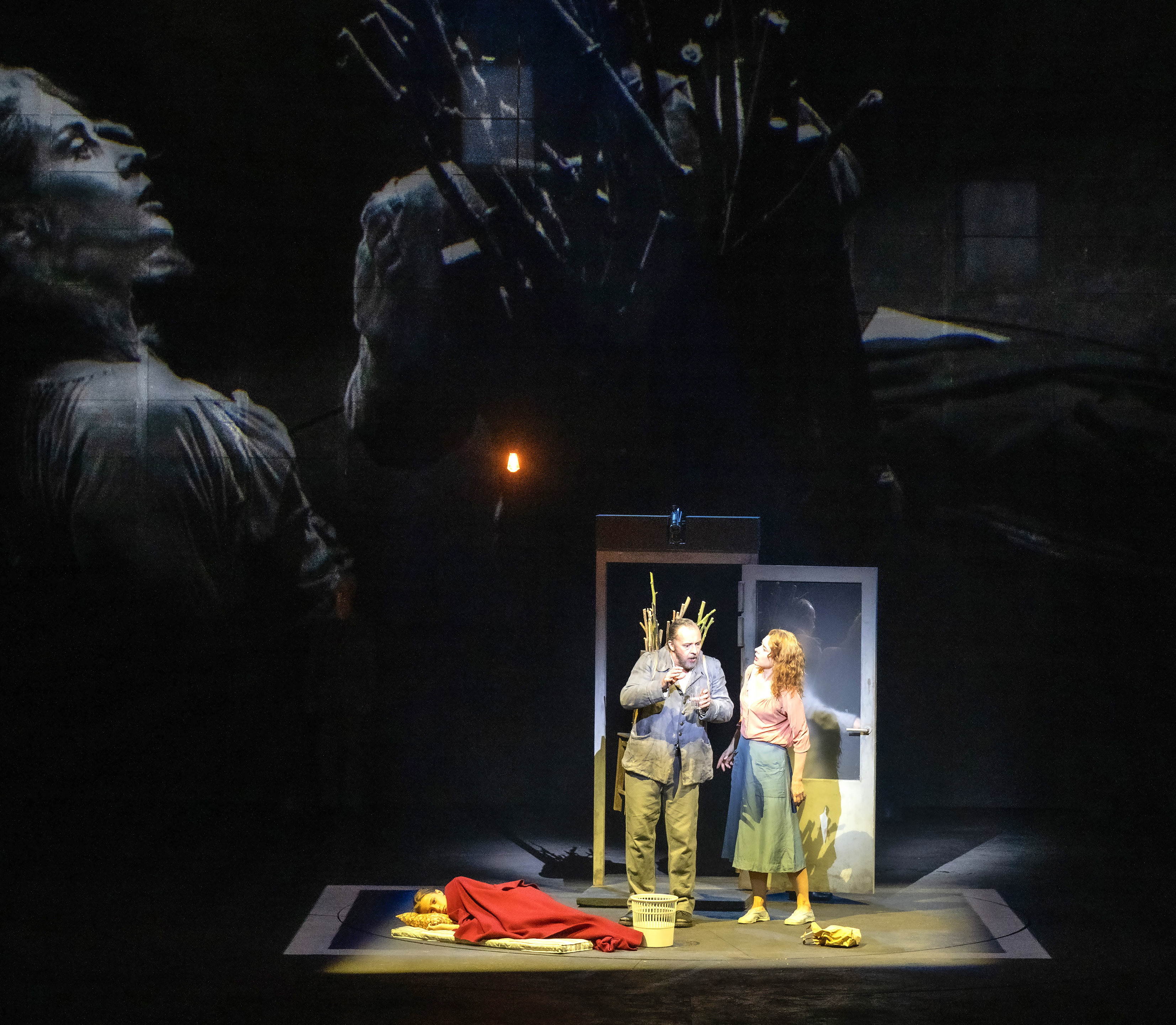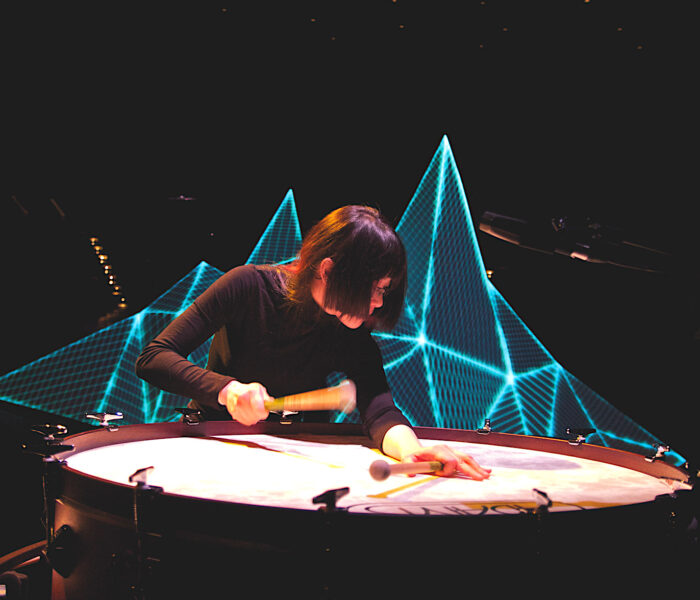Le kantele est un vieil instrument traditionnel finlandais. La virtuose Eija Kankaanranta en joue et improvise pour de nombreux répertoires modernes et compositions contemporaines.
Entretien réalisé le 14 février 2021
Comment avez-vous choisi de vous former au kantele et de jouer de cet instrument ? Est-ce une histoire de longue date dans votre vie de musicienne ou une découverte récente ?
J’ai d’abord appris le piano à l’âge de 5 ans, conformément à la tradition familiale. À 11 ans, ma mère m’a suggéré de prendre également des cours de kantele. Mon premier professeur s’intéressait beaucoup à l’élargissement du répertoire de cet instrument et encourageait les compositeurs et compositrices à écrire pour lui. Il poussait les élèves à jouer toutes sortes de musiques. Ayant joué des dizaines d’arrangements de musique folklorique (parce qu’autrefois c’était le seul répertoire), les compositions originales pour le kantele m’ont toujours apporté beaucoup de nouveauté et d’inspiration. Je suis entrée à l’Académie Sibelius, avec une spécialisation en kantele classique, et j’ai obtenu mon diplôme en 2000. Mon travail artistique comprend des projets très variés en tant que soliste, musicienne de chambre, musicienne d’orchestre, membre de groupe et artiste qui sort des disques. J’enseigne également le kantele et sa pédagogie à l’Académie Sibelius, Université des Arts d’Helsinki.
Le kantele est un instrument traditionnel finlandais, proche de la cithare. Pouvez-vous nous en dire plus sur lui : sa facture, son histoire, les contextes où il est habituellement joué, son répertoire ?
Le kantele finlandais appartient à la famille des psaltérions baltes et plus largement des cithares. Les instruments les plus anciens avaient souvent 5 cordes et étaient taillés dans un seul bloc de bois. Le nombre de cordes et la taille de l’instrument ont progressivement augmenté au fil du temps, parallèlement à l’évolution de la musique. Aujourd’hui, il existe un large éventail de modèles de kantele et de styles de jeu, du kantele à 5 cordes au kantele de concert en passant par le kantele électrique doté de 39-40 cordes et d’un mécanisme de levier permettant les changements chromatiques et la modulation. Ce qui est remarquable avec le kantele, c’est que les différents modèles historiques ou traditionnels et les styles de jeu classiques sont utilisés aujourd’hui à côté des kanteles modernes et des techniques de jeu contemporaines. Deux luthiers spécialisés fabriquent des kanteles de concert et 4 à 6 autres fabriquent de petits kanteles.
Le répertoire couvre un large éventail de musiques, allant de la musique ancienne à la musique contemporaine, en passant par le classique, la musique traditionnelle, le folk contemporain, la pop, le rock, les chansons à texte, etc. Le kantele est un instrument populaire et vous pouvez apprendre à en jouer partout en Finlande, dans les écoles de musique, les conservatoires, les associations de loisirs, etc. Il existe des professeurs spécialisés dans les musiques folklorique et classique, tout comme des cours de pratique professionnelle à l’Académie Sibelius.
Les personnes qui jouent du kantele classique se concentrent principalement sur la musique contemporaine et parfois sur la musique baroque, voire le répertoire classique pour piano et harpe de compositeurs tels que Bach, Haendel, Rameau, Dowland, Weiss, Ibert, Debussy, van Delden, Schenk, Sibelius.
Jouez-vous souvent pour des œuvres de compositeurs et compositrices contemporains, comme l’opéra “Only the Sound remains” de Kaija Saariaho où je vous ai découverte ? Pourriez-vous me donner quelques exemples ?
Oui, je me concentre avant tout sur la musique contemporaine et l’improvisation. J’ai récemment travaillé avec Juhani Nuorvala, Miika Hyytiäinen, Lara Poe, Karmit Fadael (Pays-Bas) et Christopher Fitkin (UK) qui vient d’écrire une fascinante pièce pour kantele solo de 110 minutes.
L’une de mes collaborations les plus intéressante a été avec Kaija Saariaho pour son opéra Only the Sound remains:
Certains de ces compositeurs et compositrices puisent également leurs influences dans le jazz ou le rock, fusionnant ainsi différents styles, ce qui est toujours intéressant. J’ai notamment collaboré avec un nouvel ensemble, Con Fusion fondé par la compositrice finlandaise Asta Hyvärinen. Ses oeuvres sont à la fois contemporaine et très rythmée et les instruments sont originaux: basson, kantele électrique, basse et percussions dont elle joue elle-même. Des oeuvre originellement composées pour d’autres instruments ont fait l’objet de nouvelles versions formidables. Le magnifique Concertino de Juhani Nuorvala a été originellement composé pour clarinette basse et bande et nous en avons créé une version pour le kantele électrique en 2014 . Plus récemment, Tony Uhm, compositeur basé au Japon, a écrit une version pour le kantele de son oeuvre pour harpe et bande, Der Frühling, en 2020.
Je joue également en duo avec la flûtiste Camilla Hoitenga (USA),un trio Superpluck avec Assi Karttunen (harpsichord) et Rody van Gemert (guitare) et je joue avec Lisbeth Diers (Danemark) dans un quartet dano-finlandais (kantele, percussion, piano / accordéon et guitares) .
Vous jouez sur un kantele électrique, un bel instrument rouge, avec des pédales électroniques et des effets. Est-ce une version personnalisée ?
J’ai deux kanteles de concert acoustiques, un kantele électrique (couleur lie de vin) et plusieurs plus petits. Certains ont été spécialement fabriqués ou modifiés pour moi, comme ceux à 5 et 15 cordes sur lesquels j’ai joué pour l’opéra de Kaija Saariaho.
J’utilise différents effets et outils pour jouer sur tous mes instruments, pas seulement sur le kantele électrique. Par exemple, dans l’opéra de Saariaho, je joue des kanteles à 5 cordes avec des crayons et du kantele de concert avec des maillets dulcimer pour élargir le champ sonore créé par les doigts ou les ongles. Le son des instruments est également modifié par des effets sonores et une programmation conçus par Saariaho elle-même. Les compositeurs et compositrices sont très doués pour trouver de nouveaux sons et il m’arrive de leur présenter mes propres expérimentations et pour qu’ils puissent les intégrer à leur travail.
Vous improvisez souvent avec le kantele : De manière générale, quel est le lien entre tradition et création dans votre travail ?
C’est une question difficile. Je me plais à penser que je suis plutôt libre dans mes improvisations, même si, bien entendu, l’esprit et le jeu sont influencés par tout ce que l’on a préalablement joué et entendu.
Si je tente d’analyser mes improvisations (ce que je fais rarement), je suppose que j’utilise des techniques de jeu et des sons que j’ai déjà utilisés (pour des compositions ou des créations personnelles) et que j’essaie d’en tirer de nouvelles choses. C’est vraiment agréable d’écouter, réagir et créer ensemble sur le moment, en étant conscients de ce qui se passe en temps réel, en construisant une narration ou une œuvre commune —tout est possible et se déroule dans l’instant.
Lorsque j’improvise en solo, j’ai tendance à me diriger plutôt vers une forme ancienne de minimalisme, vers la pop ou le jazz, à l’instar de Summertime de Gerhswin, Novitango de Piazzolla, Dream de John Cage ou Chameleon d’Herbie Hancock, pour ne citer que quelques-uns des morceaux que j’ai joués et sur lesquels j’ai improvisé lors de concerts solo. L’improvisation occupe aussi une place importante pour certains ensembles dans lesquels je joue. Le groupe Juurakko par exemple, fait sa propre musique en combinant des éléments de blues et de folk.
Dans un nouveau duo avec la chanteuse Aino Peltomaa nous associons les chants des Brigittines, du folklores finlandais et de la tradition carélienne à l’improvisation.
Est-ce que vous jouez aussi de la musique traditionnelle finlandaise sur votre instrument ?
Oui, cela arrive. L’idée de séparer ou classer la musique en différents genres me semble inutile voire un peu dépassée. De par mon parcours et ma formation je viens de la musique classique mais je trouve mon inspiration dans toutes sortes de musiques.
Je ne veux pas sous-estimer ni diminuer l’histoire ni la tradition, mais j’ai toujours été fascinée et inspirée par le travail avec les compositeurs et compositrices et la découverte de nouvelles œuvres. Je m’intéresse aussi beaucoup à la danse et aux arts contemporains.
Bien entendu, l’histoire du kantele et la tradition historique et ancestrale du kantele carélien et finlandais sont tout à fait fascinantes et constituent une riche source d’inspiration pour les musiciens et compositeurs de kantele modernes. J’ai appris les styles de jeu traditionnel à l’Académie Sibelius et j’ai quelques idées personnelles sur la musique ancienne du kantele (même si cette musique a évolué au XIXe siècle avec l’apparition de nouveaux instruments comme le violon). Je ne peux prétendre être une professionnelle de la musique folklorique ni traditionnelle. Je reste avant tout centrée sur le répertoire classique et contemporain de musique de chambre.
Propos recueillis par Guillaume Kosmicki



)






